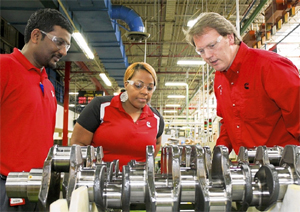According to the EPA, one of the biggest impacts a company can make when it comes to setting business sustainability goals is to examine its energy use and transportation processes. In recent years the EPA has offered suggestions for businesses just beginning their environmental sustainability programs. In addition to suggestions from the EPA, corporate case studies are also informative tools for budding Six Sigma professionals who want to learn from the best.
Cummins, Inc. Six Sigma Methodologies Yield Impressive Results
 For over a decade, Indiana-based Cummins, Inc. has been utilizing Six Sigma methodologies in the pursuit of aggressive sustainability goals. For those unfamiliar with Cummins, the 94 year old organization is a global power leader and their industry influence is noteworthy. As stated on their website, they “design, manufacture, distribute and service diesel and natural gas engines and related technologies, including fuel systems, controls, air handling, filtration, emission solutions and electrical power generation systems.”
For over a decade, Indiana-based Cummins, Inc. has been utilizing Six Sigma methodologies in the pursuit of aggressive sustainability goals. For those unfamiliar with Cummins, the 94 year old organization is a global power leader and their industry influence is noteworthy. As stated on their website, they “design, manufacture, distribute and service diesel and natural gas engines and related technologies, including fuel systems, controls, air handling, filtration, emission solutions and electrical power generation systems.”
The organization employs close to 48,000 people working in approximately 190 countries and territories around the globe. They coordinate with 600 company-owned and independent distributor locations and over 6000 dealer locations. In 2013 their sales amounted to approximately $17.3 billion dollars.
Working together with their clients, employees and other stakeholders, they have used the Six Sigma framework for more than a decade to promote, share and improve ways to help operate their organization more effectively. Increasing the efficiency and effectiveness of the products themselves, along with teaching clients efficient and effective ways to use the equipment, has resulted in more than $5 billion dollars in savings in less than 10 years.
Further, Six Sigma metrics have helped the company document a savings of over 90 million gallons of fuel since 2005. In addition to fuel savings, approximately one million tons of carbon dioxide (CO2) has also been eliminated through improved products and processes.
According to their 2013-2014 sustainability report, Cummins Inc. have also used Six Sigma to:
- Continually improve defects and variations in both manufacturing and business processes
- Help community partners improve efficiency of regional programs
- Develop new products and services
- Promote a common problem-solving language across its diverse domestic and international workforce
Goals Include Providing Six Sigma Training for Workforce
In addition to applying Six Sigma methodologies in nearly every facet of its organization to improve environmental sustainability, Cummins also invests in the sustainability of its workforce. From 2000 to 2013, over 15,000 employees received Six Sigma training.
The company understands that investing in employee training means cultivating a higher level of proficiency in proven problem-solving skills used to address the needs of customers and other stakeholders around the globe.
Always Improving: Current Goals
The organization’s current goals at the time of this posting not only include a more integrated global supply chain, but also include very specific goals for continuing to reduce its energy and water use, as well as achieve a zero disposal status at multiple sites.
Specifically, their current sustainability goals include:
- Reducing water consumption by 33% (adjusted to hours worked) and accomplishing a water neutral rating at 15 manufacturing sites with an emphasis on prioritizing water usage in water-stressed countries by 2020
- Increasing corporate recycling from 89% to 95% with 30 sites achieving “zero disposal status” by 2020
While not all companies have the world-wide influence of Cummins, all organizations can take a critical and creative look at their operational procedures, their products/services and their facilities in order to address sustainability challenges inherent to their own situations. Understanding and applying Six Sigma applications can be an important factor in designing and implementing business sustainability programs across industry.

Business Sustainability has Community Impact
Lasting and perpetual change not only requires external stakeholder support through investing in client relationships, but also involves long-term internal employee support. Investing in employee training helps create teams that achieve excellence for in-house projects and can foster community partnerships.
Cummins’ investment in their workforce training not only serves the company, but also the community. In 2013, employees throughout the organization completed over 150 Community Impact Six Sigma Projects. This record illustrates the impact that responsible business practices can have beyond profits – an impact on the lives of workers and community partners who benefit from these meaningful partnerships.
